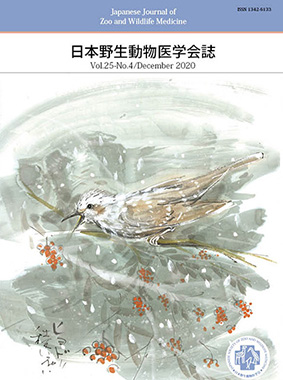
- Issue 4 Pages 119-
- Issue 3 Pages 91-
- Issue 2 Pages 41-
- Issue 1 Pages 1-
- |<
- <
- 1
- >
- >|
-
Nanaho MOROHASHI, Michiya SANO, Kosuke KATO, Hideto TOYODA, Tomoaki NA ...Article type: Full paper
2020 Volume 25 Issue 4 Pages 119-127
Published: December 24, 2020
Released on J-STAGE: February 24, 2021
JOURNAL FREE ACCESSCapybara (Hydrochoerus hydrochaeris) is the biggest rodent in the world which lives in South America and well-known at Japanese zoos. Because the placental structure of capybara is similar to human placenta, the use of capybara as an experimental animal is also being considered. It is essential to understand the reproductive physiology of capybara for the planned breeding. However, there are few information about the reproductive physiology of capybara. In the present study, we tried to establish the method of blood sample collection and vaginal smear inspection using husbandary training (no anesthesia and retention). Then, the steroid hormone concentration in plasma and feces was examined to identify the estrous cycle and pregnancy in capybara. Plasma or fecal samples were collected from non-pregnant and pregnant capybaras and steroid hormones were determined by ELISA. In non-pregnant individuals, changes in blood progesterone (P4) and estrone-3-sulfate (E1S) concentrations showed clear estrous cycle-like changes for 3 cycles (average 11.7 ± 0.9 days). Change in blood E1S concentration were consistent with change in fecal estradiol (E2) and appearance of anucleated keratinized epithelial cells in vaginal smear inspection. Fecal E2 concentrations of non-pregnancy capybara also changed like the estrous cycle. In fecal samples of pregnant capybara, the concentration of P4 were higher than that in the non-pregnant capybara. Fecal P4 and E2 concentrations were higher during pregnancy and gradually reduced after parturition. These results suggest that the estrous cycle in capybara may be identified by determining plasma P4, E1S and fecal E2 concentrations and vaginal smear inspection, and pregnancy of capybara can be predicted by measuring the P4 concentration in feces.
View full abstractDownload PDF (1583K)
-
Takashi IWAKI, Naoya SATA, Hideo HASEGAWA, Kayoko MATSUO, Takafumi NAK ...Article type: Research note
2020 Volume 25 Issue 4 Pages 129-134
Published: December 24, 2020
Released on J-STAGE: February 24, 2021
JOURNAL FREE ACCESSTrematode specimens were collected from the oral cavity of 4 species of snakes (Elaphe quadrivirgata, Elaphe climacophora, Rhabdophis tigrinus, Gloydius blomhoffii) captured in western Japan from year 2011 to 2019. They were identified as Ochetosoma kansense by morphological and genetic analyses. Because this species has been known to be distributed in North America, this is the first record of O. kansense from Japan.
View full abstractDownload PDF (919K)
-
Yohei KOBAYASHI, Naoko MIZUTANI, Naohiro IKENAGA, Masaji MASEArticle type: Case report
2020 Volume 25 Issue 4 Pages 135-139
Published: December 24, 2020
Released on J-STAGE: February 24, 2021
JOURNAL FREE ACCESSAn outbreak of avian poxvirus infection was confirmed in Japanese cormorants used for "cormorant fishing" in July 2017 in Yamanashi Prefecture. Also in July 2019, another outbreak of this disease was confirmed in a different group of birds. In both cases, the typical lesions in pox were observed visually in the beak and eyelids. As results of virological examination, avian poxviruses were isolated from samples in both cases.
View full abstractDownload PDF (1202K) -
Severe Jackknife-like Kyphosis Malformation in the Fetus of a Free-ranging Sika Deer (Cervus nippon)Ayaka HATA, Yuto SUDA, Midori SAEKI, Tatsuki SHIMAMOTO, Hisashi YOSHIM ...Article type: Case report
2020 Volume 25 Issue 4 Pages 141-145
Published: December 24, 2020
Released on J-STAGE: February 24, 2021
JOURNAL FREE ACCESSA malformed fetus was found in the uterus of a hunted wild sika deer (Cervus nippon) in Japan. Computed tomography, gross pathological and histopathological examinations revealed multiple congenital deformities, including severe jackknife-like kyphosis, exposure of the abdominal viscera, cleft palate, cleft muzzle, excess dorsiflexion of the digits in the right forelimb, third and lateral ventriculomegaly, aberrant lobulation of the lung, and imperforate anus. No pathogens associated with congenital malformation in ruminants were detected. This case report is the first to describe a severe congenital fetal malformation in a free-ranging sika deer; however, the cause of the malformation remains unknown.
View full abstractDownload PDF (608K)
- |<
- <
- 1
- >
- >|